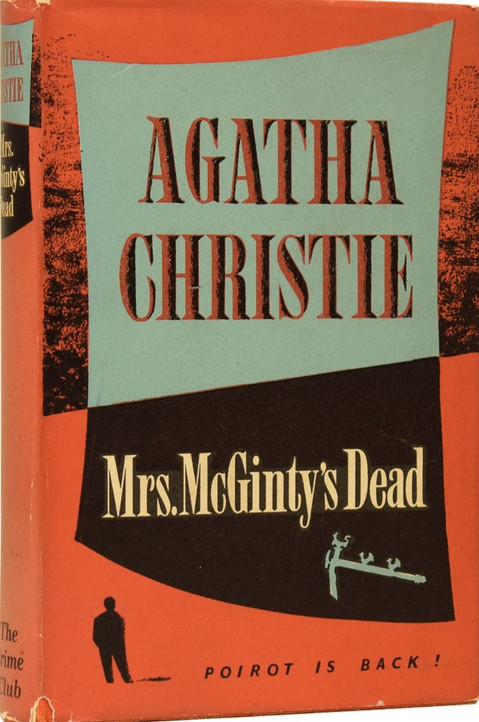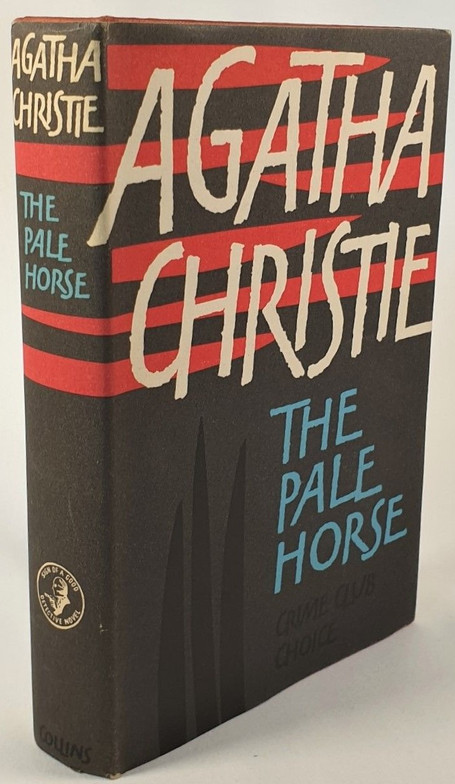INSIGHTS: Agatha Christie's Ariadne Oliver stories.
- David Morris

- Dec 3, 2022
- 8 min read
Updated: Dec 11, 2022
This year (2022) marked 90 years since Agatha Christie’s character Ariadne Oliver first appeared in print. Below is all you could ever want to know about this character and the books she is found in.
While the character of Mrs. Oliver was infrequently used by Christie, there are eight books (seven novels and one short-story collection) that reference her, and they span 40 years. Since it can be fairly speculated that the character was a subtle self-satire and alter-persona of Christie herself, Mrs. Oliver’s comments & traits across these books should be enjoyed through those lenses. Christie was even quoted in John Bull magazine in 1956 stating "the character of Ariadne Oliver does have a strong dash of myself". Consequently, as a sub-genre for collectors, a focused collection on these titles can be a fun endeavour.
The First Appearance of Mrs. Oliver:
The first time the character of Mrs. Oliver appeared in print was in the short stories The Case of the Discontented Soldier and The Case of the Rich Woman. These were first published, along with three other stories in issue 554 (Vol. 93, No. 2) of Hearst's International combined with Cosmopolitan magazine, August 1932 (USA).
Collectively they were published under the sub-heading of Are You Happy? If Not Consult Mr. Parker Pyne. Mrs. Oliver was one of Parker Pyne’s assistants. In the UK, Mrs. Oliver first appeared in issue 614 of Woman's Pictorial, 15 October 1932. However, the title was changed slightly to Adventure – by Request: The Case of the Discontented Soldier. Copies of Cosmopolitan magazine often appear for sale and can be acquired for under $50 in very good condition. However, Woman’s Pictorial is a surprisingly hard magazine to find – likely due to a much smaller print run – yet is still affordable when located.
The Books with Ariadne Oliver:
The eight books are: Parker Pyne Investigates (1934). U.S. title: Mr. Parker Pyne, Detective. Contains the two short stories in which Ariadne Oliver appeared in Cosmopolitan issue 554 – The Case of the Discontented Soldier and (retitled) The Case of the Rich Woman. All her subsequent appearances (save The Pale Horse) were in Poirot novels. They are Cards on the Table (1936), Mrs. McGinty's Dead (1952), Dead Man's Folly (1956), The Pale Horse (1961), Third Girl (1966), Hallowe'en Party (1969) and Elephants Can Remember (1972). While her books are referenced in The Clocks (1963), the character never appears in this novel so we are choosing to exclude it from the Oliver canon.
Collecting the Books:
Parker Pyne Investigates (1934):
The true first of Parker Pyne Investigates is the Collins Mystery imprint, by William Collins and Sons, UK, in November 1934. Priced 7/6 on the backstrip of the jacket, this was not a Crime Club imprint and the cloth was purple with silver lettering. The first US edition is believed to have been published in December 1934. For unknown reasons, the US title was changed to Mr. Parker Pyne Detective. It was published under the Red Badge Mystery imprint of Dodd Mead & Company, New York, consistent with Christie’s other books and priced $2.00.
The UK first edition is exceptionally rare in dust jacket and the book alone is uncommon in collectible quality. Expect to pay £1,000 for a very good condition book and £20,000 - £25,000 for a very good book in very good dust jacket. The jacket has also been seen unpriced on the backstrip which was for the overseas markets and may be considered marginally less valuable. The US first edition is much more affordable but still uncommon in jacket. For a very good book in very good jacket value is $1,500 - $2,000. For a very detailed article on this title click here.
Cards on the Table (1936):
The first appearance of this novel was in The Saturday Evening Post (USA), Vol. 208, Issues 44-49, from 2 May – 6 June 1936 (six instalments). There is no known UK magazine version of this title.
The first book was published by Collins, now using The Crime Club imprint, in London (UK) on November 2nd, 1936. The book was published with orange cloth boards with black lettering. The dust jacket was priced 7/6 net on the front flap. It was published in the US the following year in [February] 1937, by Dodd, Mead & Co., New York.
A very good jacketed copy from Collins is valued £9,000 - £13,000, while the US first would be worth $1,000 - $1,750. Each copy of The Saturday Evening Post generally sells for $50, so the complete set is worth $300.
Mrs. McGinty’s Dead (1952):

This novel first appeared in the Chicago Sunday Tribune newspaper (US). Serialised from the 7th October to the 30th December 1951, it was published under the title of Blood Will Tell. It was also published in the UK in Woman's Journal, serialised from December 1951 onwards.
The first book printing was in February 1952 when it was published as a Red Badge Detective Mystery by Dodd, Mead & Co, New York, USA. The book references copyrights for both 1951 & 1952, is priced $2.50 on the front flap, and cites numerous Christie titles on the fly sheet adjacent to the title page. It has become a surprisingly difficult book to find in very good or better condition.
Value for a correct US first in near fine copy is now $350. In the UK, it was published by The Crime Club, Collins, London on the 3rd March 1952. This book was sold both in the UK and overseas, and only reflects a 1952 copyright. The domestic jacket is priced 9s 6d net, while the export version has an unpriced jacket. Value for a near fine copy with a priced jacket is £250.
Dead Man’s Folly (1956):

This novel first appeared in magazines – both in the US and UK – before it was published as a book. It was first serialised in the US in Collier's Weekly in three abridged instalments from 20 July (Vol. 138, No. 2) to 17 August 1956 (Vol. 138, No. 4).
In the UK, it appeared in the weekly magazine John Bull in six abridged instalments from 11 August (Vol. 100, No. 2615) to 15 September 1956 (Vol. 100, No. 2620).
The book was first published in the US by Dodd, Mead and Company in October 1956 and in the UK by the Collins Crime Club on November 5th, 1956. The correct first edition (US) is priced $2.95 on the front flap. The UK printing was priced 12/6 net (twelve shillings and sixpence) on the front flap.
Value for a near fine copy UK first with a priced jacket is £175. The US first in near fine condition can be acquired for $150 or less, but be certain to avoid the similar book club edition which is in an unpriced jacket and does not cite other Christie titles on the fly sheet adjacent to the title page.
The Pale Horse (1961):
The novel was first serialised in the UK weekly magazine Woman’s Mirror in eight abridged instalments from 2 September to 21 October 1961. The first book was published in the UK by Collins' The Crime Club on 6 November 1961 and by Dodd, Mead and Company in the US in the following year.
The correct first state US jacket references the compilation “Make Mine Murder” on the rear flap and is priced $3.75 on the front flap. The second state jacket while priced the same cites numerous brief review quotes related to “The Pale Horse” on the rear flap. The UK edition’s jacket flap is priced 15/- net (fifteen shillings). Value for a near fine copy with a priced jacket is £150. The US first in near fine condition can be acquired for $75 or less.
Third Girl:
First published in the UK by the Collins’ The Crime Club in November 1966 and in the US by Dodd, Mead and Company in 1967. The US book is priced $4.50 on the front flap and the correct first state jacket has a review of At Bertram’s Hotel on the rear flap. Later Book Club editions had a blank rear flap and showed no price on the front flap.
The UK edition was priced 18/- (eighteen shillings) on the front flap. A near fine UK copy can be acquired for £60 and a near fine US copy for under $50. While the story appeared in Woman’s Own (UK) and Redbook (heavily condensed) in the US, never preceded the book. The more valuable and rare collectible is the first Fontana paperback with the slight mistitle of “The Third Girl”. Full story on this paperback book - click here.
Hallowe’en Party:
The book was first published in the UK by the Collins’ The Crime Club in November 1969 and in the US by Dodd, Mead and Company later in the same year. The UK edition retailed for 25s net (twenty-five shillings). In preparation for decimalisation in 1971, it was also priced on the dustjacket at £1.25. The US first printing is priced $5.95 on the front flap and references the upcoming Greenway editions on the rear flap.
A near fine UK copy can be acquired for £50 and a near fine US copy for under $50. While the story was serialised in Woman’s Own (UK) and Cosmopolitan (US) in later 1969, neither preceded the book. For a very detailed article on this title, click here.
Elephants Can Remember:
The book was first published in the UK by the Collins' The Crime Club in November 1972 and in the US by Dodd, Mead and Company later in the same year. The UK edition retailed for £1.60. The correct first state US edition is priced $6.95 on the front flap and both flaps contain the book’s preview.
A near fine UK copy can be acquired for £30 and a near fine US copy for under $30. The book was never published in a magazine in the UK or US, though it did appear in a Toronto, Canada, newspaper supplement the following year.
Ariadne Oliver’s Own Works & Characters:
Throughout these various Agatha Christie novels (and The Clocks), eleven books by Ariadne Oliver are mentioned by title. There were also three published articles she references. Oliver's most famous works are those featuring her vegetarian Finn detective Sven Hjerson. While none of these books or articles exist maybe one day Agatha Christie Limited will authorize their creation. That's not too unrealistic given that Ariadne Oliver’s character has been used in the television show “Agatha Christie's Hjerson”, a Swedish production with Mathew Prichard as one of the executive producers. The first episode was broadcast in August, 2021 and the first season comprises 8 episodes. It is generally accessible worldwide now.
Oliver’s Fictional Writings:
Referenced in Cards on the Table are The Lotus Murder, The Clue of the Candle Wax, The Body In The Library, The Death in the Drain Pipe, and The Affair of the Second Goldfish (also mentioned in Mrs McGinty's Dead). Two other novels are mentioned in Mrs. McGinty’s Dead. They are The Cat it Was Who Died and Death of a Debutante. Other books are The Woman in the Wood (mentioned in and based on her experiences from Dead Man's Folly), The Dying Goldfish (mentioned in Hallowe'en Party), The White Cockatoo (mentioned in The Pale Horse), and lastly The Second Goldfish (alluded to in Elephants Can Remember).
The three articles – all referenced in Cards on the Table – are The Tendency of the Criminal, Famous Crimes Passionnels, and Murder for Love vs. Murder for Gain.
Well these article has likely provided you more information that you ever wanted about Christie's character of Ariadne Oliver. But we hope you enjoyed it. Do let us know if there are any corrections or additions of references we missed.
Happy Hunting!












































Regarding the UK edition of Mrs. McGinity's Dead "This book was sold both in the UK and overseas, and only reflects a 1952 copyright as it was not published in the UK in any form prior to this. " FYI on ebay right now is the UK Woman's Journal February 1952 which has the 3rd installment of this story (so there is a prior UK publication).
There is a Sven Hjerson short story